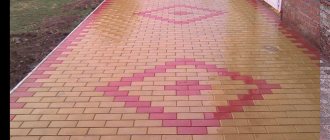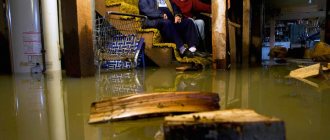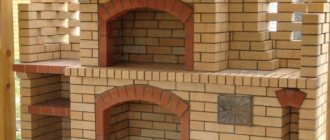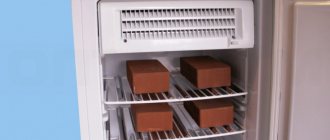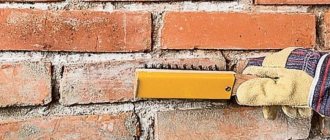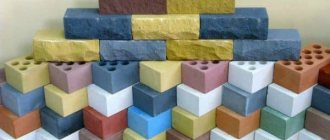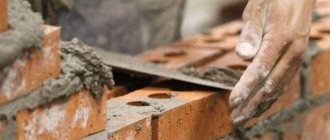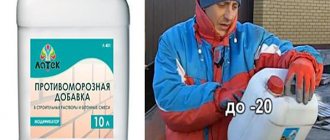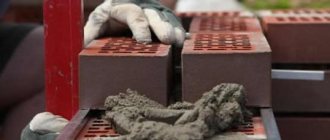How to remove white plaque on brick
Very often you can encounter a situation when an almost new building or any other brick structure begins to become covered with a white coating.
And over time, the area of white spots only increases. These are the so-called “efflorescences”. As a rule, plaque is visible on red glossy or decorative brick, but white sand-lime brick, foam concrete, natural stone and even slate are also susceptible to it.
The appearance of efflorescence on a brick means the slow destruction of the surface.
White deposits on brick are salts that can fall on the surface during rain or snow, can also be contained in cement mortar, or get into the masonry with various additives, for example, for quick hardening.
Very often, the appearance of white spots can be a consequence of groundwater and poor waterproofing of the foundation.
During drying and evaporation, the water tends to outward, and the salt crystallizes, leaving white or even green spots on the surface, and as a result, the brick cannot withstand and first begins to lose its aesthetic appearance, and then completely collapses.
How to most effectively approach this issue?
There are many methods of removal, but it is important to remember that there are a huge number of types of salts, and thus the approaches to removal will vary.
To begin with, you can try to wash off the plaque with running water and brush it.
But if this method does not work, then feel free to go to a hardware store and buy a chemical cleaner specifically for plaque on brick. Fortunately, at the moment there are plenty of such cleaning products on sale, but they may differ in composition and are intended for certain types of salts.
In such a situation, it is better and cheaper to buy several types of cleaners and experimentally determine which one is best for you, rather than order a chemical analysis of efflorescence on the wall.
Determining and calculating the amount of cleaner for a specific area is quite easy. Approximate consumption is written on each package. The substances contain various acids and chemical elements, so it is necessary to follow safety precautions. Wear rubber gloves, goggles and a respirator, as well as clothing that protects the surface of the skin.
How to remove white plaque on brick? The chemical must be diluted with the specified amount of water indicated on the package. Next, the resulting solution must be applied to the damaged areas of the wall, and you can use a brush, roller or other equipment. Leave for the period of time specified in the instructions and rinse with water using a brush.
If the surface of the wall was covered with a large amount of salt, and the first time it was not possible to clean it completely, you should do this operation again. At the moment, existing chemical cleaners allow you to completely get rid of white deposits on bricks. Your surface will be like new and you will get rid of the problem of how to remove white plaque on brick for a long time.
We recommend
DOCKER FASADE is a product for removing efflorescence. Designed for quick and effective removal of efflorescence from various mineral surfaces. Penetrates deeply into the surface, dissolving and removing salts throughout the entire depth of impregnation. Does not change the properties and structure of the surface. Removes salts mainly of carbonate, lime and sulfate origin. Concentrate. No chlorine. Economical consumption. Fast acting (5-10 min.)
How to remove efflorescence from brick?
Step-by-step removal
Stagnation of water between blocks and their saturation with water causes black fungus or mold. Darkened brick indicates increased dampness, yellow and green spots on the masonry indicate the presence of vanadium salts. If you do not fight the white coating, then salt corrosion occurs on the walls. This is a phenomenon in which, due to temperature changes, salt stains begin to destroy the brick, roughness appears on it, and the surface chips. However, it is impossible to restore damaged masonry. To avoid corrosion, you need to immediately get rid of plaque. It is necessary to clean efflorescence, treat walls, and use specialized additives. To eliminate efflorescence on brickwork, we carry out the following actions:
- We take a brush or a large brush and treat the plaque with a primer.
- Pour water over the surface.
- We use special compounds to reduce the porosity of the block.
- We are waiting for the wall to dry.
- At the end, it is necessary to treat the surface with water-repellent compounds.
Homemade remedies
If it is not possible to use special solutions for pickling, you can make a cleaning liquid with your own hands, using available compounds. You can clean the walls from plaque with vinegar diluted in water and detergent. We treat the masonry with vinegar solution. This wash perfectly replaces the composition for pickling. Ammonia and hydrochloric acid solution help remove plaque. If the stone has darkened, painting will help, but first eliminate the cause of the dampness.
Ceramic brick
The most common anti-efflorescence products are for red ceramic stone. White spots on a silicate product are difficult to see, but on facing bricks (red) the efflorescence is clearly visible, which spoils the appearance of the facade. The stains on the yellow Lipetsk building material also look unpresentable. Red bricks require special attention, because there is a risk of color fading. The most effective method is proprietary formulations using Trilon Chelaton III. This helps prevent fading on the ceramic brick. Contamination from facing is removed with special detergents (it is necessary to clean the walls from white deposits with a brush), vinegar (it allows you to remove the contaminants out, then it can be easily washed off with water). Phosphoric acid also helps get rid of efflorescence on ceramics.
How to remove salt from brick: folk and chemical remedies
Facing brick is the most common building material for exterior decoration of buildings. It gives the structure a beautiful, attractive appearance and has a long service life. But sometimes after construction is completed, whitish spots and stains appear on the brick. This kind of plaque on the walls of a brick building is called efflorescence. Where do they come from, why are they dangerous and what to do about it?
Causes of efflorescence on a brick wall
Efflorescence on a brick wall occurs for the following reasons:
- The brick is made from cheap raw materials with a high content of salts and other impurities;
- To prepare masonry mortar, water with a high content of hardness salts is used; when it begins to evaporate, a white coating appears on both the mortar and the brick;
- When making the masonry mortar, sand with a high salt content was used; if it is not washed, the resulting masonry will also have efflorescence;
- Violations in construction technology, namely, insufficient waterproofing at the foundation-wall interface. As a result, moisture can be sucked into the masonry.
- Carrying out masonry work in damp, rainy weather or excessive dilution of the solution with water for ease of use.
- The use of various frost-resistant additives and plasticizers.
- Wetting of brickwork due to the lack of gutters and roof eaves on the building.
Any of the listed factors, either individually or in combination with others, can cause efflorescence.
Regardless of the reason, the mechanism for the appearance of efflorescence is as follows: when moisture gets into a brick (during its manufacture or already during operation), it naturally evaporates. The moisture evaporates, and water-soluble salts crystallize on the surface of the brick, forming a white coating.
Why are efflorescences dangerous and why should they be removed?
Salt stains on a brick wall not only spoil its appearance and disrupt the aesthetics of the building - this is only the first signal that not everything is in order with the facade and measures need to be taken.
More importantly, efflorescence gradually destroys the brick, and the process begins from the inside. Salt by itself will not dissolve or be washed away by rain. Repeating cycles of moisture absorption-evaporation-crystallization, combined with temperature changes, turns brick into a brittle material that begins to crumble and collapse.
Some time after the appearance of a white coating, scales and husks form on the surface of the brickwork, which eventually begin to fall off. The tension in the brick grows and it literally “tears” from the inside. This process is called salt corrosion.
How to remove efflorescence using special chemicals
Salt stains on brickwork can and should be removed, but this should not be done using ordinary water, as it increases the moisture content of the brick, and when it dries, the salt will appear on the surface again.
The use of special chemicals in this case is justified; moreover, it is reliable and safe if you follow the rules of use.
In modern construction supermarkets you can find a large selection of cleaners based on organic and inorganic acids with the addition of surfactants.
There are always instructions on the jar with the cleaner, which indicate in what proportions to dilute the product with water, how to apply it, and how long to wait before rinsing. For application, sprayers, rollers, and natural brushes are used. After distributing the product, you need to wait from 10 minutes to half an hour, and then rinse it off with plain water. You cannot use metal objects for this; a wooden scraper or a stiff brush is sufficient.
When using chemicals, it is imperative to follow safety rules: use gloves, goggles and respirators, and avoid contact of aggressive substances with exposed skin and mucous membranes.
The complete process of cleaning and protecting brickwork from efflorescence consists of the following steps:
- Removing efflorescence using a special solution and a brush.
- Rinsing the brickwork with plenty of water, you can use a household mini-wash for convenience or other devices.
- Treatment with a special composition that reduces the porosity of the brick, which prevents further release of salts to the outside.
- Application of a water-repellent substance, which creates a protective film on the surface that does not allow moisture to pass through. It is recommended to apply this product in 2 layers. After applying the first, you need to wait 24 hours, then apply the second layer to the completely dry brick. The water repellent can penetrate up to 1 cm inside the brick, providing protection from moisture for 5-10 years. Then it needs to be reapplied.
Removing salts from masonry
To complete the information, it should be noted that salt does not always appear on the masonry solely due to the absorption of atmospheric moisture. Additives added to the solution - antifreeze or accelerating setting - may also be to blame. The water used for mixing and the quality of the sand, which must be washed, are of great importance.
Capillary absorption of moisture occurs primarily due to the absence of layers of rolled waterproofing material between the base of the foundation and the basement wall, and between the base and the wall of the house. Moreover, this material should not be laid dry - it should be glued to bitumen mastic.
Usually this is a whole complex of factors that lead to the same result. People who do construction with their own hands do not always know about such seemingly trifles, or simply do not attach importance to them. And then they rack their brains: “How to remove efflorescence on brick?” It’s good that there are means that allow you to fight this, frankly speaking, unaesthetic phenomenon.
All means are good to fight
Before discussing the process of cleaning masonry, let's figure out how to remove efflorescence on brick. It is impossible to do this without a special tool.
Well, you wash the facade, and salt deposits will appear again and again - and this will continue until you do everything right. Let's see what the retail network offers us for this purpose.
- One of the most popular brands of products intended for cleaning efflorescence is Neomid-550. This is a universal option that can be used not only for brick, but also concrete and stone surfaces.
- The concentrated composition is diluted in half with water before removing efflorescence on the brick. If cleaning must be done at sub-zero temperatures, alcohol can be used instead of water. It is packaged in bottles with a capacity of 1 l, 3 l and 5 l, and costs approximately 400 rubles. per liter
How to remove efflorescence on facing bricks: anti-salt Neomid -550
- The composition produced under the Good Master brand is equally effective and inexpensive. It penetrates deeply, dissolves and removes salts from the pores. Perfectly removes even old plaque. Packaged in 5l and 10l canisters, cost 450 and 860 rubles. respectively. It does not require dilution, as it is already ready for use. Unlike the previous option, it contains acid and removes all types of salts.
- The “Anti-vysol Aqua” product is generally a universal cleaner. It is effective not only against soluble salts, but also against sulfate and carbonate deposits, so it can be used not only to remove efflorescence, but also to clean the facade from traces of masonry mortar.
The drug is also active against fungus and mold, which greatly simplifies the task, eliminating the need to also buy a biocide. With the exception of limestone and marble, it can be used to treat any surface.
The cleaner is ready for use, packaged in plastic containers of 5 liters and 10 liters, and costs around 300 rubles. per liter
Masonry processing process
There are a lot of products designed to remove salts - we have presented only a small overview. As for the process of applying them, no matter which option you choose, the processing is carried out in the same way.
First, the wall must be prepared by cleaning the flaking areas of the masonry from pieces and crumbs of brick, as well as using a metal brush to treat those places where there are significant salt deposits. They need to be cleaned off so that only whitish spots remain.
Cleaning brick walls
If the salt cleaner works effectively, within a couple of minutes the treated area will become clean. Apply such compositions as a regular primer - with a roller or brush. You can also use a spray bottle, but then the consumption will be slightly more than stated by the manufacturer.
After waiting the prescribed number of minutes after applying the drug, it should be rinsed with water from a hose with good pressure. Then, the walls need to be allowed to dry, and the protective silicone impregnation mentioned above can be applied.
How to clean white plaque from brick
How to clean white plaque from brick, expert advice.
How to get rid of efflorescence on a brick wall is the topic of today’s article. First of all, let's understand the concept itself - efflorescence. Let's find out what they are and where they come from.
Currently, materials such as brick and wood are coming back into fashion. They are rightfully considered the most common building materials.
Brick is not only used to build walls, but is also used as a facing material for the external walls of a house.
At the same time, a person believes that this facade will serve for a long time and delight the eye with an attractive appearance.
However, quite often, such expectations are not met. And the owner observes a white coating on the surface of the brick wall.
- 1 What is efflorescence 1.1 Reasons for the appearance of white plaque
- 1.2 How to clean white plaque from brick
- 1.3 How to prevent salt corrosion
- 1.4 How to remove white plaque from brickwork
- 1.5 White plaque on brickwork, methods of control
What is efflorescence
White stains on the surface of a brick are called evictions. The composition of the brick and the mortar used to lay the wall may contain various types of salts.
As a result of exposure to moisture, salts are washed away and carried to the surface. The moisture evaporates, and the salt crystallizes and remains on the surface of the brick wall.
The appearance of white spots and stains on a brick wall indicates serious problems that will occur if no measures are taken.
When salts are washed away, the masonry and bricks begin to collapse. This is expressed in the peeling of small fragments from the brick. Which ultimately leads to the destruction of the entire structure.
Evictions are an indicator that the brick structure has entered a phase of destruction. This phase is called salt corrosion.
Causes of white plaque
There are several reasons why white plaque appears.
Sometimes, this can be caused by incorrect actions of the mason:
- When using large amounts of water.
- Construction of walls in rainy weather.
- Use of antifreeze additives.
- Adding hardening accelerators, plasticizers, and so on.
- In case of violations of house construction technologies. for example, lack of waterproofing and so on.
But, most often, evictions occur for the following reasons:
- Low quality bricks;
- Chemical composition of water;
- The sand used to mix the solution may have a high concentration of salts.
Also, evictions can be triggered by non-compliance with the operation of the finished building.
- Lack of gutters on the building;
- The walls are not treated with a water repellent to protect against moisture.
Whatever the reasons that provoke the appearance of white streaks, you need to urgently take measures to eliminate the problem.
How to clean white plaque from brick
Although, to be honest, cleaning the brick is just part of the story. To prevent evictions, the façade of the building should be protected from moisture.
That is, to stop the further process of destruction of brick and masonry. And it is best to prevent the appearance of salt corrosion at the initial stages of construction.
How to prevent salt corrosion
To prevent salt corrosion of brickwork, it is recommended:
- Build walls in dry, warm weather;
- Use good quality bricks with a low moisture absorption coefficient;
- Add coarse sand to the solution;
- Use water with low salt content, in minimal quantities. You can replace some of the water with liquid soap or detergent. The solution will be elastic, but with a low moisture content;
- Protect the masonry from rain and other moisture;
- Do not wet the walls unless absolutely necessary; if the solution gets on the bricks, let it dry and then clean it with a dry brush;
- Upon completion of the masonry construction, allow it to dry and treat the walls with a water repellent. This composition will cover the wall with a water-repellent, protective film. Which not only protects the structure from moisture, but also prevents destruction and strengthens the masonry;
- Take care of the timely installation of drainage systems, drains, cornices, and so on. That is, reduce contact with moisture as much as possible.
How to remove white plaque from brickwork
In order to remove white stains that have already appeared, you should wash the wall with a special cleaning agent. The name of this product is a cleaner for efflorescence from brick and clinker.
You can also use cement deposit remover. This remover also does a good job of removing salt and limescale deposits from brickwork.
In addition, you can make such a solution yourself. Take a ten-liter bucket of water. Add five tablespoons of vinegar and the same amount of detergent to it.
Stir the prepared mixture and wash off the white coating from the wall.
Let the masonry dry. If the white coating has disappeared, then treat the wall with a water repellent.
We have already written about how to protect brickwork from moisture. We advise you to read about the basic rules for using water repellents.
A wall treated with a water repellent does not absorb moisture. Drops of rain or condensation roll down.
And such facades look much more attractive than untreated ones. Since the protective film gives the facade the effect of wet brick. The color of the masonry turns out darker and more saturated.
At the moment, the most effective in terms of protecting the facade from moisture are silicone water repellents. They do not wash off and retain a protective film for a long time. At the same time, the silicone film allows the brick to “breathe” freely.
White plaque on brickwork, methods of control
Efflorescence on brick: methods of removal and causes of appearance
Good afternoon dear friends. With you again, the Holtz Bio LLC team.
Today we will talk about such a phenomenon as the appearance of a white coating on brick, the so-called “efflorescence”.
Here it is, the long-awaited day. The stove is folded, the fire is playing in the firebox. It seems that everything is over, now you can calmly enjoy the warmth of your favorite stove.
But, somehow, getting up early in the morning, you noticed white spots and plaque on your brick stove. And of course, the expected reaction: an immediate call to the stove maker, the supplier of materials, and as a result - spoiled nerves and mood... But don’t be upset! Beautiful brick is restored without efflorescence, unlike nerve cells (as doctors say).
So, let's figure out what efflorescence is and where it comes from.
Efflorescence
- these are salts released by brick or mortar when moisture evaporates, which remain on the surface of the brick. Salt gives efflorescence a white tint (efflorescence sometimes comes in other colors: yellowish, greenish, brownish).
In most cases, there is no need to be afraid of white plaque. Efflorescence does not damage the performance of the brick.
Causes of efflorescence and ways to combat them
Most often, efflorescence appears as a result of the natural drying of masonry. When the water contained in the mortar and brick evaporates, salt appears on the surface of the brick. These are "young salts"
- they are
easily
washed off from the masonry and do not appear again.
If after removal the plaque appears again, then the problem is deeper. What other reasons could there be for efflorescence?
- Poor-quality masonry mortar: the proportions of water and mixture are incorrectly chosen, the use of low-quality sand, etc.
- Low-quality brick: some manufacturers use various admixtures in the brick production process to reduce the cost of production.
- High air humidity: pipe leaks, roof and chimney leaks. Atmospheric precipitation – regarding open barbecue complexes.
How to deal with efflorescence? How to defeat white plaque forever?
First method: treat plaque with distilled water. If this doesn't help, then move on.
Second method: you need to purchase a special solution to remove efflorescence.
Use this solution to treat problem areas and wait until dry. If efflorescence appears again, then there are still problems.
If the cause of the plaque is high humidity, then it is necessary to eliminate the cause of the leak , then wait for efflorescence to appear and return to the first and second methods.
And of course, let’s consider the most unpleasant option
– this is low-quality mortar and brick. In this case, the plaque is not washed off, but erased mechanically. First, use a spatula and then use a brush to remove the mortar from the brick. After removal, it is necessary to treat the seams with a purchased solution to remove efflorescence. It is very important to process only the seams without touching the brick!
And of course, a couple of tips from us:
- To avoid repeated efflorescence on stoves and fireplaces, we recommend covering it with stove varnish.
This will protect the brick from getting wet and salts appearing.
- For owners of outdoor barbecue complexes and barbecues, it is imperative to treat the brick with water repellents. This will help protect your brick and nerves!
Reasons for the appearance of efflorescence on the wall of a house
On beautiful, red brick walls, every attentive owner will immediately notice white stains, but not everyone will attach importance to this or begin to act promptly to quickly eliminate the strange whitish pattern in the masonry. And this wave-like pattern is efflorescence and should be removed very quickly.
Efflorescence, in its essence, is ordinary salt that appears on the surface of a brick. Brick is a hard, porous sponge that perfectly absorbs moisture, and it, in turn, contains various salt impurities. At a certain temperature, salts naturally “evaporate” onto the surface of the brick, which, when dry, crystallize on the surface, forming sloppy stains. If it seems to you that the area of efflorescence is insignificant, do not delude yourself and do not hope for chance. Only a small part of all the salty “wealth” contained in the building material appears on the wall.
The appearance of efflorescence is a consequence of excess moisture. Salt deposits are found almost everywhere and their appearance on a brick surface does not depend on a person at all.
The reasons themselves are quite banal and lie almost everywhere:
- The material from which the bricks are made contains a certain amount of salts. Thanks to the moisture easily absorbed by the brick, these chemical elements are dissolved and brought to the surface of the building material under the influence of high temperature during the evaporation of the liquid.
- The water that is added during the brick production process introduces its own portion of salts.
- Another recipe component in brick production that adds a fair amount of salts is sand, which contains a lot of lime. And, if it is not washed between cycles: mining in a quarry - adding to the brick batch, then the brick will obviously be fairly “over-salted”.
- The soil on which the house stands also tries to keep up with everyone and makes its salty contribution to the emergence of a salt problem.
- Natural precipitation in any form - where would we be without it? And in cases where a chemical production or enterprise is located nearby, an increased portion of salt is provided to everyone.
- Lack of conservation of masonry in the autumn-winter period, if the construction process is interrupted for any reason.
The appearance of efflorescence should not be taken as a death sentence for your building. The same as letting everything take its course. Efflorescence is a kind of call for protective measures and preventive checks of roofs, eaves, drains, window sills, and the integrity and reliability of waterproofing. If you correctly carry out all the work to eliminate efflorescence on brick with your own hands or take preventive actions to prevent the appearance of efflorescence, then your head and conscience will be free for a long time from solving such a problem.
Efflorescence on the stove - what to do?
Is white plaque spoiling the appearance of your stove? In composition, it is ordinary salt, which is released from stone or mortar when moisture evaporates. The water leaves, and the salts it contained remain on the surface of the brick in the form of plaque - efflorescence. Usually it is white, less often it has a yellowish, greenish or brown tint.
For what reasons does efflorescence appear?
1. Natural drying of the masonry. The water contained in the mortar and bricks evaporates and carries its salts out. Experts call them “young”. They are easily washed off and do not appear again.
2. Poor quality masonry mortar: • violation of the proportions of water content and masonry mixture; • use of unwashed quarry sand in the furnace solution; • water with a high salt content has been added to the solution.
3. Poor quality brick. Manufacturers, in order to reduce production costs, add various additives to it, allowing firing at lower temperatures. This reduces the cost of the production process, but at the same time reduces quality.
4. Broken waterproofing and high relative humidity. Leaks in heating or water supply pipes, penetration of moisture through the roof or chimney, precipitation in the case of outdoor barbecues and barbecue complexes - all this leads to the appearance of salt stains on bricks.
The plaque will not go away on its own. It needs to be fought, washed off and prevented from reappearing. There are different methods to combat it, from modern to time-tested.
If, as a result of the natural drying of the masonry, so-called “young salts” have appeared, it is enough to simply wash them off with special means (solutions for removing efflorescence) and not be afraid of their reappearance. Such products are sold in construction stores. They contain organic or inorganic compounds, they have a wide spectrum of action and not only protect against efflorescence, but also remove oil stains, lime deposits, and traces of exposure to atmospheric precipitation. You can try to wash off the salt deposits with distilled water.
If the cause of efflorescence is damaged waterproofing or high humidity, then you first need to eliminate the cause itself - cracks in masonry, tears in waterproofing layers and roofing, damage to the integrity of connections and pipes of water mains, and the like. After eliminating the cause, you need to wait until the brick dries and the efflorescence appears, and then start washing it off.
The outer surface of outdoor barbecue ovens or brick grills can be protected from potential salting out using special solutions - water repellents. The substances included in such solutions prevent the penetration of external moisture into the masonry and the leaching of salts onto the surface of the brick. Of course, before processing, the salt deposit must be washed off and the masonry dried.
Well, if the reason for the appearance of efflorescence is the poor quality of the brick or the incorrect composition of the working solution, then get ready for a stubborn struggle. In this case, washing off the plaque with water will not help, but on the contrary will worsen the situation, delivering more and more salt to the surface. What to do? Efflorescence should not be washed off from the surface, but washed using dry and semi-dry methods, that is, mechanically, using spatulas and dry brushes, first remove salt deposits from the surface, and then lightly moisten a rag in a solution for removing efflorescence, wipe away the remaining stains without wetting the brick. After removing the plaque, in order to avoid its reappearance, you can coat the stove with varnish, which will “seal” the brick and masonry mortar from getting wet and salts leaching onto the front surface.
To successfully remove salt deposits using any of the described methods, first try it on a small area of masonry, which will help you see how effective one or another method is and choose the most effective one.
Efflorescence on brickwork
White stains may sometimes appear on the walls of buildings - efflorescence on the brick. Salt appears on them, which evaporates from the liquid that has entered the block due to various reasons. Such stains appear on houses, spoil the appearance of buildings (the wall turns white), destroy bricks, and are difficult to remove. Fighting efflorescence takes a lot of time, but it is best to prevent its occurrence in advance.
Why do they appear?
The appearance of efflorescence is provoked by various reasons:
- Low quality of materials and mortar - use of cheap or porous bricks, water from natural sources, unwashed sand, pre-soaking of blocks when laying;
- Natural factors - low temperature, humid air, salinization of the soil under the house, aggressive precipitation;
- Lack of drains - without them, the walls are not protected from excess liquid.
If salt stains appear, check the roof, drainage system, and repair if necessary. Their malfunction can cause excessive soaking of the brick and the appearance of plaque. Don't forget to insulate the foundation.
Is it possible to warn and how?
It is better to prevent the appearance of “white spots” at the construction stage by following these rules:
To prevent plaque from appearing on the material, you need to avoid laying it during rain.
- Do not lay masonry in cloudy or rainy weather, or with high air humidity.
- Follow the recommended norms for introducing antifreeze and other additives into the solution, make it a little tougher.
- Clean the sand.
- Initially, do not allow the bonding mixture to get on the masonry; if this happens, wipe it off.
- Use a special composition that repels water.
Return to contents
Products resistant to efflorescence
- Clinker brick is a facing material known not only for its interesting appearance, but also for its protective ability. It protects the walls of houses and fences from precipitation, while being durable and strong. White efflorescence on clinker bricks appears in the form of growths or films, destroying the surface and spoiling the appearance of the decorative material. Removal of efflorescence is sometimes limited to rinsing with water. The stains on clinker are not severe, but sometimes a concentrated cleaning agent is needed. After removing the “drips,” the surface is treated with protective compounds to prevent the appearance of efflorescence.
- “The Fifth Element” - this facing brick is of good quality, but at the same time it costs more than the usual one, the same “Slavic” one. Plaque on a brick occurs if it is laid incorrectly. Defects in masonry can ruin the work and spoil the appearance with efflorescence. It is important to carefully study the masonry technique and follow it, avoiding getting a large amount of liquid onto the bricks and into the mortar. Elimination of efflorescence is carried out using special means. But basically these bricks are not affected by them.
Question answer
Question No. 4777
Question No. 4771
Efflorescence is a rather poorly soluble structure, since the whitish coating may contain sulfate-sodium compounds, carbonate-sodium, carbonate-calcium. In addition, efflorescence may include aluminum, silicon, and iron-containing inclusions. As a result of exposure to atmospheric and industrial emissions, soluble salts become insoluble, which significantly complicates their removal.
Technological means for cleaning walls from whitish deposits are solutions of acids based on phosphoric acid, hydrochloric acid and others. NOTE! When choosing an efflorescence remover, you should test it on a small surface. Since not every chemical composition may be suitable for certain drugs.
Efflorescence remover NEOMID 550
designed to remove mineral and phosphate efflorescence and is made on the basis of hydrochloric acid. The composition works in 90% of cases.
If the efflorescence is of a different nature, then it is necessary to select a product with a different acid.
In some particularly difficult cases, chemicals based on organic and inorganic acids do not help.
The white coating may not have been removed from the surface of the brick due to its strong moisture. If the wall is still wet, or you wet it heavily while washing off the remaining solution with water, then when it dries, a new portion of salt appears on the surface from the thickness of the wall with evaporating moisture.
